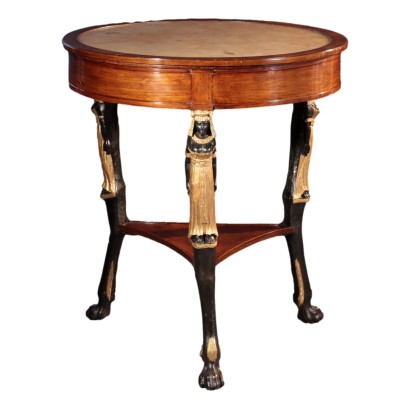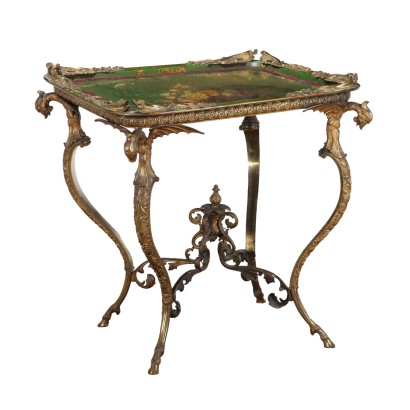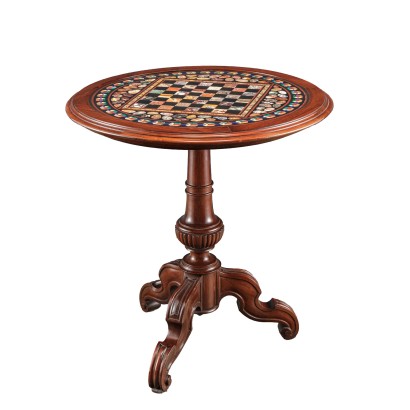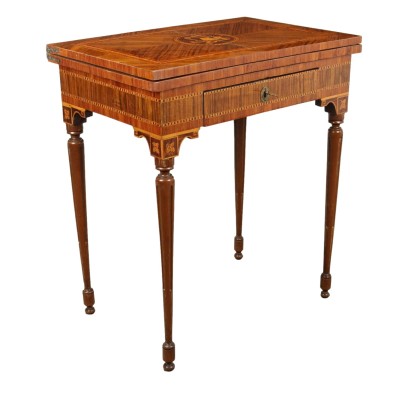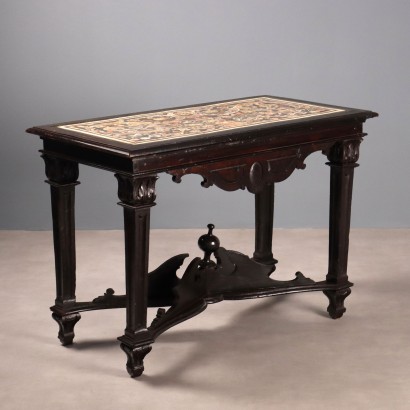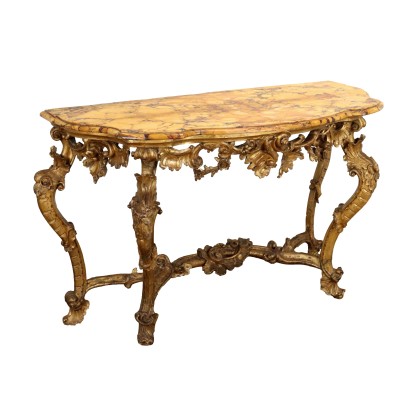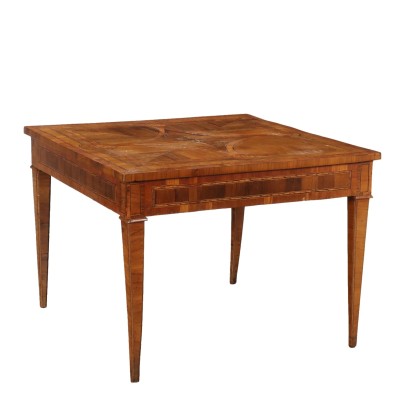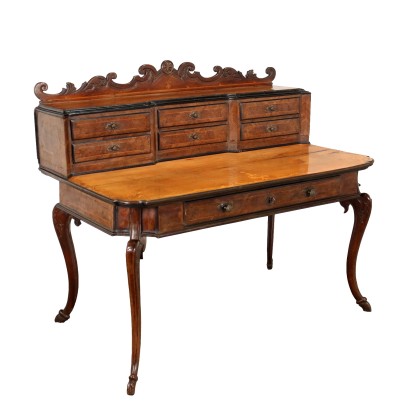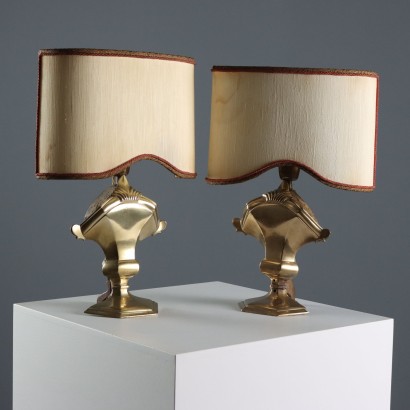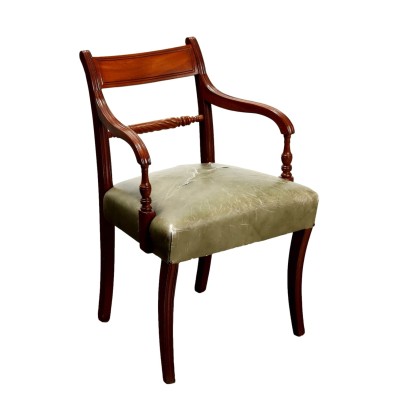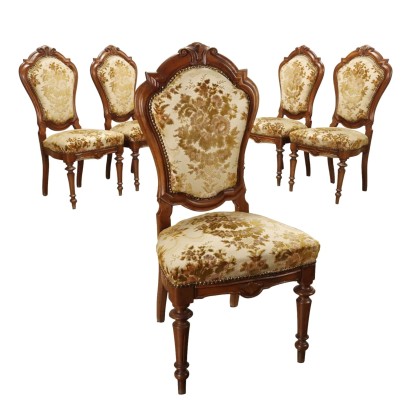Antique Side Table Empire Cherry Alabaster Italy XIX Century - Kingdom of the Two Sicilies First Quarter 19th Century
Features
Kingdom of the Two Sicilies First Quarter 19th Century
Style: Empire (1804-1815)
Age: 19th Century / 1801 - 1900
Origin: Italy
Main essence: Cherry
Material: Alabaster
Description
Gueridon supported by three uprights carved with lion feet and in the upper part with caryatids, to support the undertop band. The female figures are standing, dressed according to the Egyptian taste: they wear a low-cut dress that leaves the breasts uncovered, tightened at the waist by a belt, they wear bracelets and necklaces, while the hair is styled according to the Egyptian taste, with braids that fall neatly on the shoulders. These figures are partly ebonized, to make the skin, while the clothes and details are gilded. The legs are connected by a platform in the shape of a concave triangle. The circular top is in alabaster, enclosed within a cherry veneered frame.
Product Condition:
Product that due to age and usage requires restoration and resumption of polishing.
Dimensions (cm):
Height: 97
Diameter: 78,5
Additional Information
Notes historical bibliographic
A particular characteristic of the gueridon in question is the solution adopted in the construction of the uprights. The Egyptian caryatids with the part representing the ebonized skin, while the clothes, the jewels and the golden hair, are found in various furnishings of Sicilian manufacture and always datable in the same chronological period. In this regard, comparisons are possible with furniture preserved at Palazzo Malaspina in Palermo, in particular a gueridon in which the central baluster is made up of telamons, therefore male figures, also dressed here according to Egyptian taste. Matches are also possible with a table in Palazzo Mirto, also in the Sicilian capital. Also in this example the plan is supported by four caryatids inspired by ancient statuary, which in this case looks more to the Hellenistic world, rather than to the Egyptian one. From the structural point of view, comparisons are possible with another table kept at the Capodimonte Museum in Naples (inv. 1907, no. 3976) and indicated as being of Sicilian manufacture. The method of embedding the marble top is similar. The poplar construction suggests that the production of these tables was not only Sicilian as the antiquarian tradition has always thought, but that there was also a Neapolitan production, probably active with Ferdinand's return to Naples after his exile in Palermo.Style: Empire (1804-1815)
Decorative style of the furniture that is affirmed under the Empire of Napoleon Bonaparte, that is, between 1799, the year of his election as consul, and 1815, the year of his definitive defeat.It has many elements of continuity with the previous Direttorio style, in the more general Neoclassical climate, which derived from the study of classical antiquity the forms and models to be inspired in the creation of furniture.
The peculiar feature of this style is a greater grandeur and courtesy of the furnishings, which had to convey the grandeur of the French nation to the world, hence the name Empire style.
The furniture is characterized by straight, majestic and massive lines, adorned with motifs dear to Napoleon such as bees, eagles, large Ns surrounded by laurel, and, after the Egyptian campaign, many elements taken from Egyptian art.
He prefers the flat bronze decorations, often gilded, to the refined carvings of previous years.
The typical essence of Empire furniture is mahogany.
Find out more with our insights:
Classic Monday: How society influences the taste in furnishings
Classic Monday: Empire, one style of furniture with political purposes
Classic Monday: in the Empire bed roots of culture
Classic Monday: the timeless charm of a toilet Empire
Age: 19th Century / 1801 - 1900
19th Century / 1801 - 1900Main essence: Cherry
Obtained from prunus cerasus , a plant of oriental origin, it is a hard wood with a light and delicate color, with a reddish vein. Due to its diffusion and availability it was used in Europe in popular furniture. In cabinet making, in the seventeenth century, it was widely used in France and England for inlay work. In Italy it was very successful in Lucca. It was also very popular in the United States for the manufacture, from the late 1600s, of commonly used furniture.The dictionary of antiques: Eclecticism
Classic Monday: a sofa from the 1800s example of eclecticism
Material: Alabaster
Other customers have searched:
Approfondimenti
Se ti interessano tavoli, tavolini, tavoli a vela, scrivanie, scrittoi e consolle dai un'occhiata ai nostri approfondimenti sul blog...Classic Monday: da un pezzo dei nostri magazzini alla storia dell'antiquariato
L'antiquariato dalla A alla Z: il Dizionario dell'Antiquariato
Il dizionario dell'antiquariato - Lastronatura
Il dizionario dell'antiquariato - Mascherone
Il dizionario dell'antiquariato - Natura morta
Il dizionario dell'antiquariato - Opificio
Il dizionario dell'antiquariato - Pastiglia
Il dizionario dell'antiquariato - Savonarola
Il dizionario dell'antiquariato - Rosone
Sui tavoli:
Il Neobarocco in un grande tavolo dell'800
Il Tavolo a fratino
Sui tavolini:
Breve storia dei tavolini
Un tavolino impero lombardo: segno di egemonia politica
Il tavolino da gioco, questo sconosciuto
Il dizionario dell'antiquariato – tavolino a Commesso
...e alle presentazioni su FineArt
Tavoli antichi:
Tavolo campionario lapideo, Roma, Opificio Raffaelli
Tavolo a vela, attribuibile a Luigi e Angiolo Falcini
Tavolo attribuibile a Luigi e Angiolo Falcini
Gueridon, Regno delle Due Sicilie, primo quarto XIX secolo
Tavoli modernariato e design:
Archivio Borsani, patrimonio di memorie e saperi
Tavolo anni '40 ABV
Tavolo Mario Vender Anni '60
Tavolo anni '50 ABV
Tavolo '522' Gianfranco Frattini per Bernini
Tavolo 'Barium' Luciano Frigerio
Tavolo anni '50, Manifattura Italiana
Tavolini antichi:
Coppia di tavolini Tomaso Buzzi, attribuiti
Tavolino da gioco, Bottega Giuseppe Maggiolini, inizi XIX secolo
Tavolino piano commesso, Toscana, Inghilterra, Metà XIX Secolo
Tavolino Piano Commesso, Amic Hotton (attribuito a ), XIX Secolo
Tavolini modernariato:
Tavolino anni '50
Tavolino anni '40 ABV
Tavolino anni '60
Product availability
The product can be seen at Cambiago
Immediate availability
Ready for delivery within 2 working days from ordering the product.

